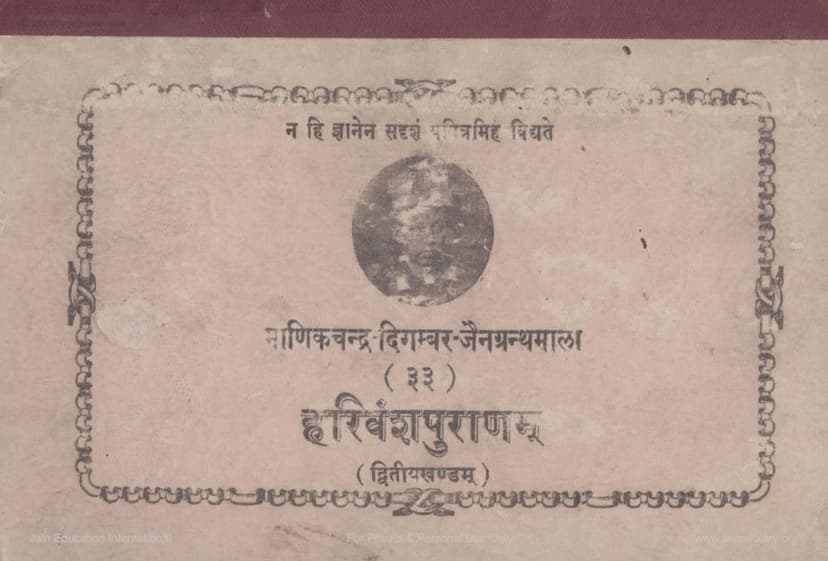Harivanshpuranam Uttararddham
Added to library: September 1, 2025

Summary
Based on the provided text, here's a comprehensive summary of the Harivanshpuranam Uttararddham:
Book Title: Harivanshpuranam Uttararddham (Second Part of Harivanshpuranam) Author: Jin Sen Acharya Compiler/Editor: Pandita Darbarilal Nyayatirth Publisher: Manikchand Digambar Jain Granthamala Samiti
Overall Summary:
The Harivanshpuranam Uttararddham is the continuation of the epic Harivanshpuranam, attributed to Jin Sen Acharya. This volume, specifically the latter part, delves into the lives and stories of the Yadava lineage, with a strong focus on the central figures of Vasudeva, Krishna, Balarama, and the eventual unfolding of the events leading up to the birth and exploits of Krishna, culminating in the narratives surrounding his descendants and the eventual decline of the Yadu dynasty, and the establishment of the teachings of Lord Neminatha.
Key Themes and Narratives Covered (based on chapter titles and content):
The text is structured into numerous chapters (Sargas), each detailing specific events and narratives. Based on the provided table of contents and snippets, the key themes and stories include:
- The Life of Vasudeva: Early adventures of Vasudeva, including his capture by Suryaka, his marriage to various princesses, and his lineage.
- The Birth of Balarama: The narrative of the birth of Balarama, the elder brother of Krishna.
- Kamsa's Tyranny and Rise to Power: The text details Kamsa's actions, his marriage to Jovativati, his acquisition of Mathura, and his fear of the prophecy regarding his downfall. It also includes the story of Vashistha and the past lives of Ramabhadra and others.
- Krishna's Birth and Childhood: The birth of Krishna, his upbringing in Gokula, his encounters with Kamsa's agents, and his early exploits like defeating Kamsa's deities and overcoming Kalia.
- Krishna's Marriages and Victories: The text recounts Krishna's marriage to Satyabhama, his battles with figures like Jarashandha, and the events leading to the establishment of Dwarka.
- The Pandavas' Story: The narrative shifts to include the lives of the Pandavas, their lineage, the conflict between Kauravas and Pandavas, their exile, various encounters, and their ultimate involvement in the Mahabharata war. The text highlights significant events such as Krishna's role in their affairs, the marriage to Draupadi, and the challenges they faced.
- Lord Neminatha's Life: A significant portion of the text focuses on the birth, life, and teachings of Lord Neminatha, the 22nd Jain Tirthankara. This includes his lineage, his query to Vasudeva about Nevi, descriptions of his divine attributes, his renunciation, his penance, and his ultimate attainment of liberation.
- The Mahabharata War: The text touches upon the epic Mahabharata war, mentioning key figures like Karna and Kunti, and events like the Chakra Vyuha and Garuda Vyuha.
- Krishna's Further Exploits: Krishna's conquests in Southern India, his interactions with various rulers, and his role in establishing order.
- The Creation of Dwarka: The narrative describes the creation of the city of Dwarka, its magnificence, and Krishna's entry into it.
- Narayada's Role: The appearance and activities of Narada, a celestial sage, are described, including his influence on events and his interactions with Krishna and his consorts.
- The Stories of Pradyumna and Other Descendants: The text chronicles the lives of Krishna's son Pradyumna, his abduction, his foster parents, and his eventual return. It also mentions the past lives of various characters, the divine births of children, and their subsequent histories, often involving transmigration and the consequences of karma.
- The Yadava Dynasty's Downfall: The text details the events leading to the destruction of the Yadava dynasty, including the curse, the internal conflicts, and the ultimate annihilation of the clan.
- Spiritual Teachings: Interwoven throughout the narrative are the spiritual teachings of Jainism, particularly the principles of right faith, knowledge, and conduct, the importance of penance, and the path to liberation as expounded by Lord Neminatha. The text includes detailed descriptions of various fasting methods (Upavasa Vidhi) and the sixteen factors of spiritual progress (Shodash Karan Bhavana).
- Genealogies and Lineages: The text provides extensive details about the genealogies of the Kuru and Yadava dynasties, tracing their lineage from ancient times and connecting them to the lineage of Tirthankaras.
Significance and Style:
The Harivanshpuranam Uttararddham is a significant work within Jain literature, offering a rich narrative that blends mythological elements with spiritual guidance. It aims to illustrate the principles of Jainism through the lives of prominent figures, emphasizing the law of karma, the cycle of birth and death, and the ultimate goal of spiritual liberation. The style is epic and narrative, common in Puranic literature, replete with descriptions of divine beings, celestial events, battles, and intricate genealogies.
Publisher's Note:
The publisher's list at the end indicates that the Manikchand Digambar Jain Granthamala Samiti has published a wide array of ancient Jain texts, making them accessible at affordable prices.
In essence, the Harivanshpuranam Uttararddham is a complex and extensive Jain scripture that provides a detailed account of a pivotal period in Jain mythology, offering spiritual lessons through the grand saga of the Yadava lineage and the celestial path of Lord Neminatha.